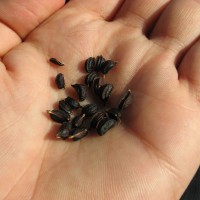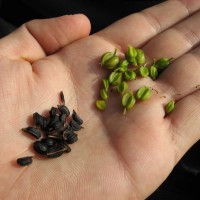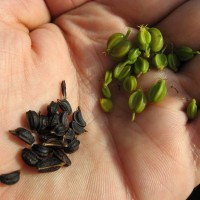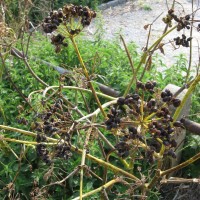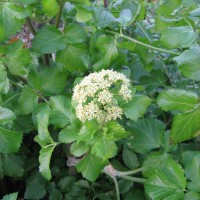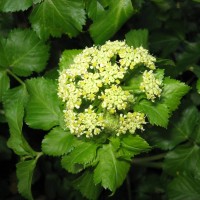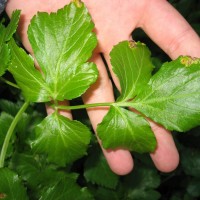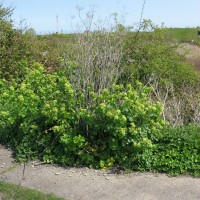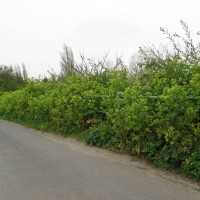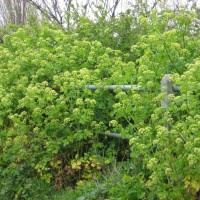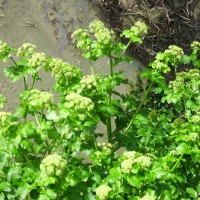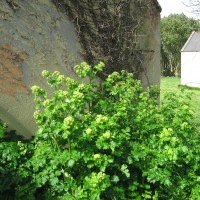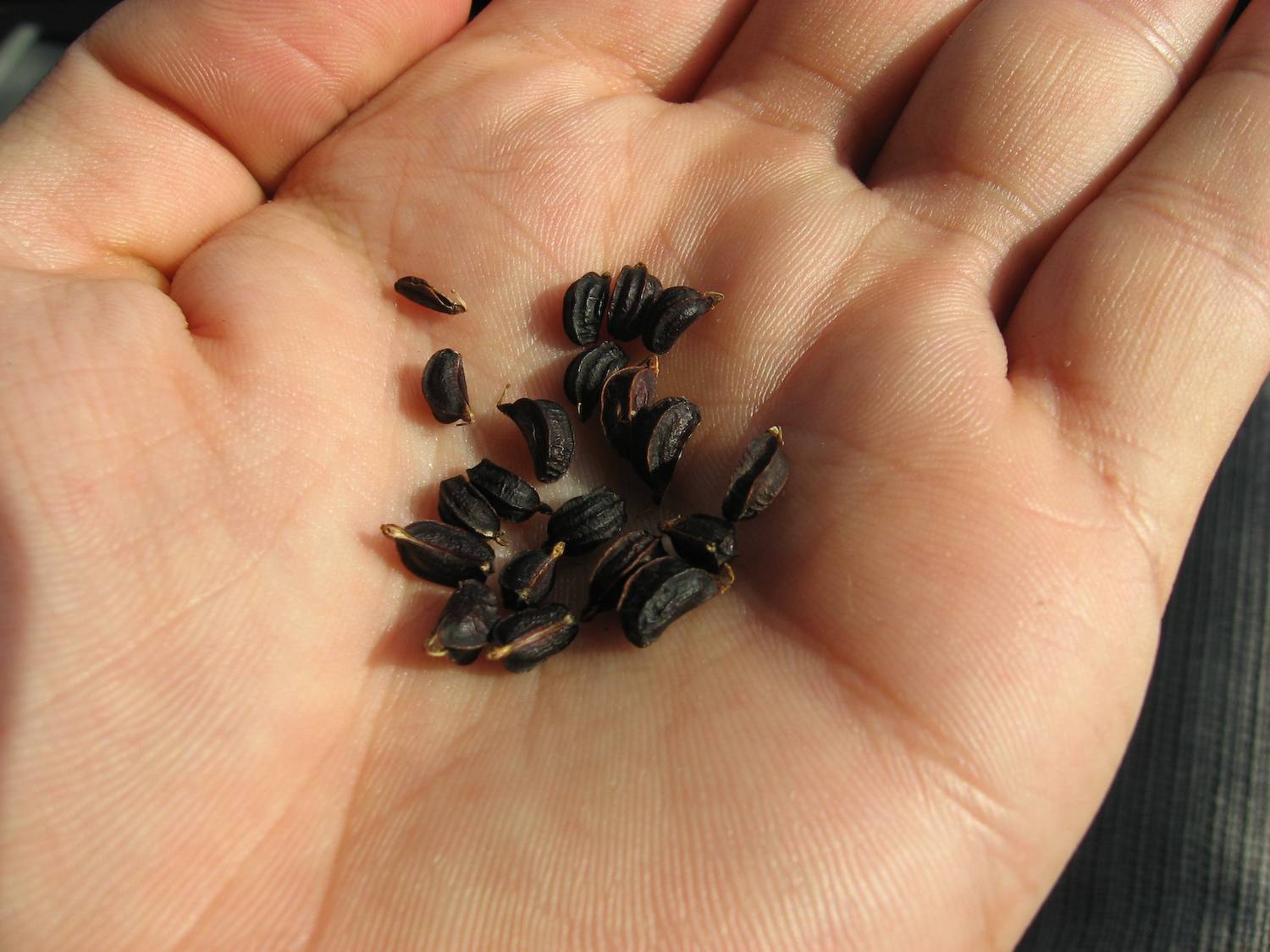
Alexanders - Smyrnium olusatrum
Expand and collapse the sections below by clicking on the title or + / - icons.
Short description of Smyrnium olusatrum, Alexanders
A stout hairless biennial to 150-200cm. Stem yellowish. Leaves glossy, with broad segments; upper leaves with a sheathing base. Flowering head a dome of yellow-petalled flowers. Fruit 7-8mm long, ridged, blackish when ripe. A rather Celery-like odour.
Impact summary: Smyrnium olusatrum, Alexanders
It can become established in grassland, scrub and woodland communities where there is a degree of disturbance creating open ground, and can then become persistent and dominant over extensive areas to the exclusion of many other spring-flowering species.
Habitat summary: Smyrnium olusatrum, Alexanders
Rank grasslands, waysides, scrub and open woodland, and the back edges of coastal communities. Almost always where there is a history of disturbance and often where there is nutrient enrichment. Preferring shelter and intolerant of frost and salt-water inundation.
Overview table
| Environment | Terrestrial |
|---|---|
| Species status | Non-Native |
| Native range | Southwestern Europe, Southeastern Europe, Northern Africa, Western Asia, Andorra, Algeria, Canary Is., Spain, France, Italy, Portugal, Turkey |
| Functional type | Land plant |
| Status in England | Non-Native |
| Status in Scotland | Non-Native |
| Status in Wales | Non-Native |
| Location of first record | v.c.5 (Somerset) |
| Date of first record | 1562 |
Origin
Usually considered to have been introduced as a pot-herb by the Romans; a fruit has been recovered from the Roman settlement at Caerwent, and remains were also found at a mediaeval site in London.
First Record
The first written record was by William Turner in 1562 on an island in the Bristol Channel (probably referring to Steep Holm where it persists abundantly).
Pathway and Method
Early spread was from its use as a pot-herb and medicinal plant, and some of the most extensive and dominating stands are still on mediaeval settlement sites. From existing sites it spreads by seed by mechanical dispersal, with little or no part played by animal vectors or by water.
Species Status
Interestingly, localised records before the early 20th century show limited preference for coastal areas except in the south-west and around the Solent. More intensive recording up to 1970 reveals a many-fold increase (probably part real, part artificial) but with a much stronger coastal bias. Since then it has continued a significant spread inland in lowland southern GB and Ireland. The record shows it to be impersistent in many Northern sites.
Dispersal Mechanisms
Dispersal (entirely by seed) is in the vicinity of the parent or very short-range in the wind. Humans clearly help it on its way but other animal vectors are unknown. Experiments suggest that desiccated seeds can stay viable in sea water for over a week, but there is no field evidence for marine dispersal.
Reproduction
Flowers are bisexual and cross-pollinated by a wide range of insects to which it provides an important early nectar source.
Known Predators/Herbivores
Browsed by rabbits, and the rootstocks may be attacked by rats. Horses eat it enthusiastically but it is apparently avoided by cows. A number of insect pests either predate or cause incidental damage. In coastal areas it is host to the rust Puccinia smyrnii.
Resistant Stages
It is most resistant to natural predation (though not immune to rodent attack) between seasons, when it persists as a rootstock and bud.
Habitat Occupied in GB
Sites generally have a history of disturbance or setttlement and a degree of shelter from frost. The most acid soils are avoided and large populations often have high nitrate and phosphate levels. Communities occupied include open woodland (particularly secondary woodland and decayed elmwood), blackthorn and bramble scrub (often successional from false oat-grass (Arrhenatherum) grasslands) and hedges and waysides with similar affinities.
There are scattered records to northern Caithness, but its main territory is mainland GB south of a line from Mersey to Wash, the eastern half of Ireland, Man, Scilly and the Channel Islands. Its inland extent is greatest in southern England, East Anglia and south-east Ireland.
Environmental Impact
In conditions optimal for the plant it can dominate the ground layer to the exclusion of other plants, but these conditions, involving high nutrient levels and some disturbed ground, will tend to acquire a limited and banal native flora in any case. It can be more problematic in some hedgerows especially in the south-west. It is valuable to insects as an early nectar source.
Health and Social Impact
Containing furocoumarins, Alexanders might be expected to cause light-stimulated dermatitis like other Carrot family members, but there is no good documentation on this. Alexanders gets some publicity as a "free food" but is probably not widely used.
Economic Impact
None known
Identification
Sell, P.D. & Murrell, G. (2009) Flora of Great Britain and Ireland vol. 3, Cambridge University Press, Cambridge.
Stace, C.A. (2010) New flora of the British Isles, Third Edition, Cambridge University Press, Cambridge.
Biology, ecology, spread, vectors
Agro, L.A. & Shattock, R.C. (1999) Interactions between isolates of Puccinia smyrnii, an autoecious, demicyclic rust and accessions of Smyrnium olusatrum. Plant Pathology, 48, 499–504.
Lovettdoust, J. (1980) A comparative study of life history and resource allocation in selected Umbelliferae, Biological Journal of the Lannean Society, 13, 139-154.
Randall, R.E. (2003) Smyrnium olusatrum L., Biological Flora of the British Isles No. 228, Journal of Ecology, 91, 321-340.
Roberts, H.A. (1979) Periodicity of Seedling Emergence and Seed Survival in some Umbelliferae, Journal of Applied Ecology, 16, 195-201.
Thompson, K. & Baster, K. (1992) Establishment from Seed of Selected Umbelliferae in Unmanaged Grassland, Functional Ecology, 6, 346-352.
Management and impact
Agro, L.A. & Shattock, R.C. (1999) Interactions between isolates of Puccinia smyrnii, an autoecious, demicyclic rust and accessions ofSmyrnium olusatrum. Plant Pathology, 48, 499–504.
General
Preston, C.D., Pearman, D.A. & Dines, T.D. (2002) New Atlas of the British and Irish Flora, Oxford University Press, Oxford.
Reduron, J-P. (2008) Les Ombelliferes de France t. 5, Societe Botanique du Centre-Ouest, Nercillac.
Spotted this species?
Distribution map
View the Distribution map for Alexanders, Smyrnium olusatrum from BSBI

